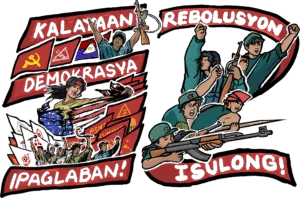III. Political requirements of people's war
The No. 1 political requirement for the new democratic revolution in the Philippines and for the advance from the strategic defensive to the strategic stalemate in the protracted people's war is the revolutionary political leadership of the Communist Party of the Philippines. The Party has laid out the general line of new democratic revolution against the semicolonial and semifeudal ruling system.
Under the guidance of Marxism-Leninism-Maoism, the Party has accumulated experience and achievements in leading the new democratic revolution. By carrying out the Second Great Rectification Movement from 1992 to 1998, it has recovered the mass base it previously lost through grave errors of "Left" and Right opportunism in the 1980s and has revitalized the armed revolutionary movement since the 1990s.
The key task of the Party in the next five years is to recruit at least 200,000 Party members in order to strengthen the revolutionary leadership and core of the revolutionary mass movement. The Party membership is an adequate base for reaching this goal within two years under the policy of expanding the Party membership boldly without letting in a single undesirable. The Party must recruit and swear in as Party candidate-members the activists in the mass organizations who accept the Constitution and Program of the Party.
Candidate-members of worker and peasant origin become full members within six months and those of petty-bourgeois origin, within one year. During the period of candidature, the concerned Party organ or unit must verify the good character and militancy of the candidate members in the mass movement and must provide to them the basic Party education. All leading Party organs and units must work fast to elevate to full membership both the backlog and the new crop of Party candidate-members.
There should be no unnecessary delays for Party candidate-members to become full members. The delays in elevating someone from candidature to full membership are often caused by negligence and lack of concern for the desire of candidate members to become full members. It suffices that the candidate-member gets the basic Party education and proves serious in carrying out his/her assigned tasks in the Party unit and mass organization.
To be able to build the Party rapidly, we must accelerate the building of the mass organizations for peasants, workers, youth, women, children, cultural activists and other sectors. It suffices at the start for the applicants/recruits to become members by accepting the program and constitution of the mass organization. Without a growing mass movement from which it can recruit candidate-members, the Party cannot expand and perform the task of arousing, organizing and mobilizing a still greater number of people. Relative to the strategic task of advancing from the strategic defensive to the strategic stalemate, both our Party organization and organized mass base are small. But they are more than adequate for us to aim for the level of strength necessary for reaching the threshold of the strategic stalemate in less than five years if we sum up well the causes of the slow growth of the Party and the organized mass base and if we set the tasks for maximizing our strength and overcoming errors and weaknesses.
The expansion of the Party organization and organized mass base in both urban and rural areas can run ahead of the expansion of the people's army. The Party and the organized mass base can grow in all congressional districts of the reactionary state. Wherever they exist, their membership must be increased. Subsequently, some of the Party members and mass activists can be redeployed from time to time in order to cover areas where the Party and mass organizations do not yet exist and are too small.
In the next five years, Party branches must be built in at least 20,000 villages and Party cadres must be developed at the regional, subregional, provincial, district or guerrilla front and section levels through various levels of Party education and through work in the mass movement. The Party cadres and members in the localities must be able to lead the work of the mass organizations, organs of political power, people's militia, barrio self-defense corps, and self-defense units of mass organizations. The people's militia assume the role of serving as the principal forces in launching local guerrilla warfare and standing as centers of gravity of the barrio self-defense corps and the self-defense units of the local mass organizations.
They must enable the units of the NPA to carry out tactical offensives. Thus, new fighting units can be created with the firearms seized from the enemy. We must depart from the old practice of overloading units of the people's army with tasks that can be performed by the local Party branches, the mass organizations and the local organs of political power that take charge of public education, economic affairs, health, self-defense, cultural activities and arbitration.
Under the leadership of the Party, the organs of political power can form and administer the people's militia and barrio self-defense corps for the purpose of internal security and police work. The mass organizations can also form and administer their own self-defense units. The members of the people's militia and barrio self-defense corps should run into tens of thousands, with every village having a militia platoon and a self-defense corps platoon. The self-defense units should run into hundreds of thousands, with every mass organization in every village having a self-defense platoon.
The NPA must put its units through distinct periods of politico-military training, combat, mass work and production. It must provide politico-military training to its combat units as well as to instructors for the people's militia and the self-defense units. NPA units may be rotated and deployed for battles for three to six months, depending on the situation. The point is to accelerate the seizure of weapons from the enemy forces. NPA units must also be rotated in mass work and production so that they remain close to the people and produce part of what they consume.
It is necessary for the Party to sum up its experience and current situation and to draw up the guidelines and plans for the NPA in every regional, subregional, provincial and district or guerrilla front level with definite reasonable targets for the number of weapons to seize from the enemy forces. What is reasonable is based on previous experience and current capabilities of the NPA units. An NPA command, for instance, may recommend to the Party committee a 10% increase in the number of weapons every three months.
Soft targets for raids, ambushes and disarming operations abound. These include police stations, small army detachments, paramilitary units, private security agencies, private armed groups and armed individual reactionaries. There are even softer targets for attritive actions to sap the strength and morale of the enemy forces, force them to do guard duty and commit mistakes in deploying troops and resources. Operations can be easily launched on the basis of intelligence buildup and timely reconnaissance.
It is by entrusting mass work and the mass movement to local Party branches, local organs of political power and the mass organizations, that the NPA can be confident that the mass base is being maintained and developed while it is concentrated on fighting and destroying the power and apparatuses of the reactionary state on a wide scale in the localities. Thus, the NPA can inspire and enable the people in the localities to take revolutionary power.
The revolutionary organs of political power grow stronger and more secure when reactionary power is destroyed and the reactionaries flee or are deprived of their local power and authority. The organs of political power should be based mainly on the mass organizations of the working people and are augmented through united front relations at various levels against the worst reactionaries.

